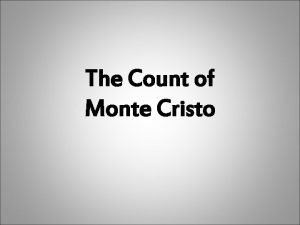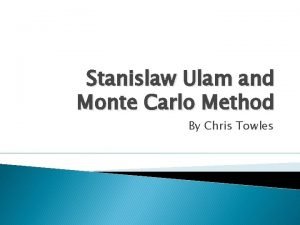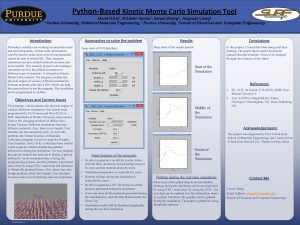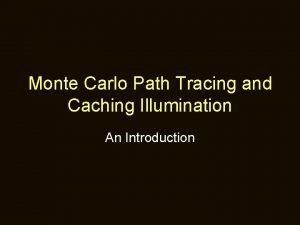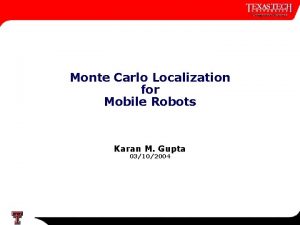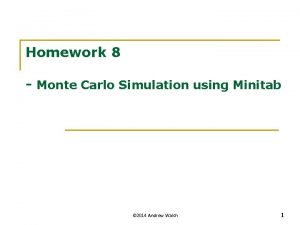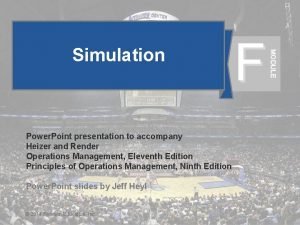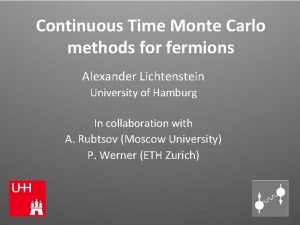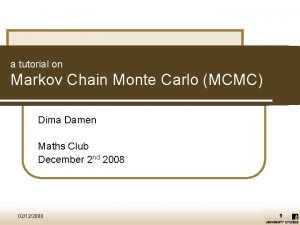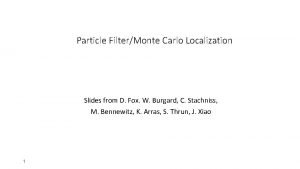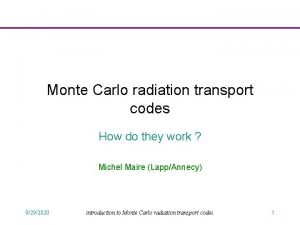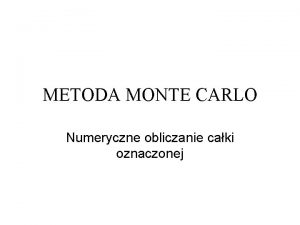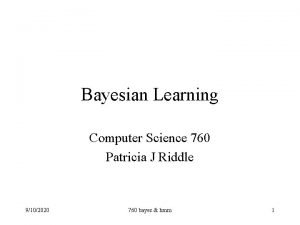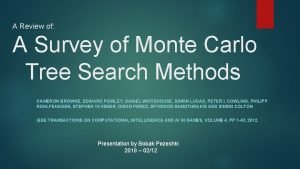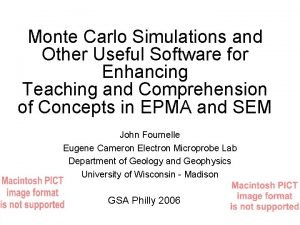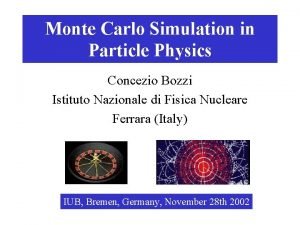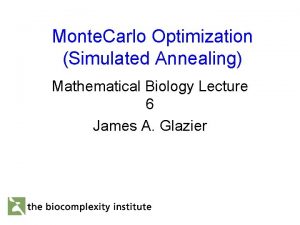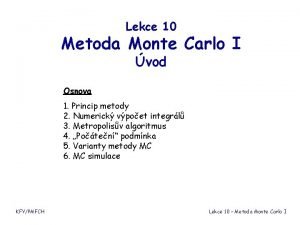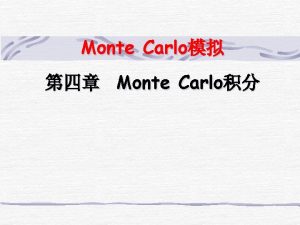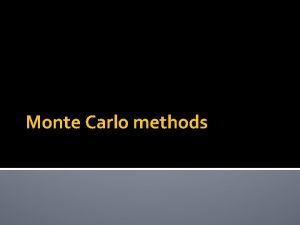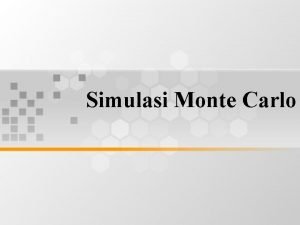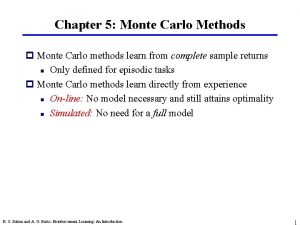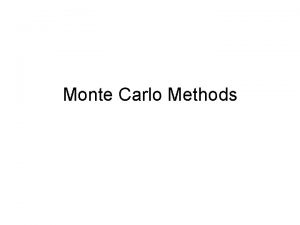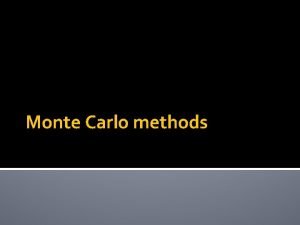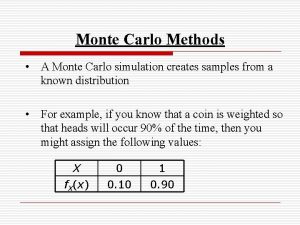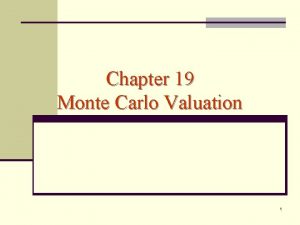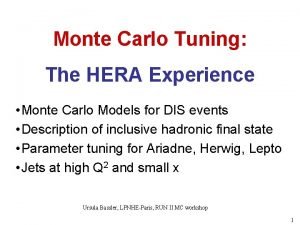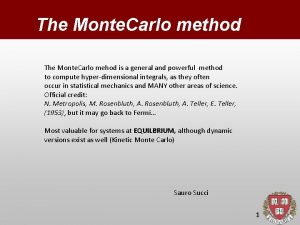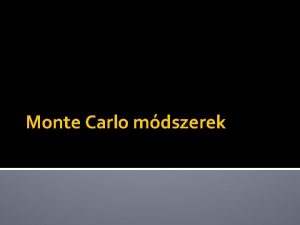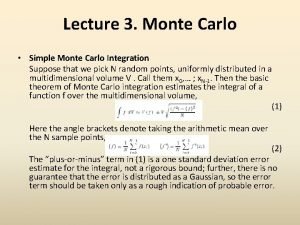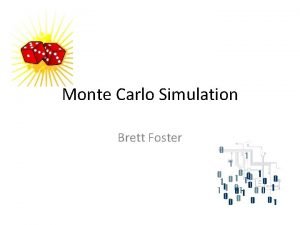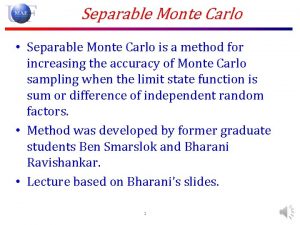Chapter 5 Monte Carlo Methods p Monte Carlo





















- Slides: 21

Chapter 5: Monte Carlo Methods p Monte Carlo methods learn from complete sample returns n Only defined for episodic tasks p Monte Carlo methods learn directly from experience n On-line: No model necessary and still attains optimality n Simulated: No need for a full model R. S. Sutton and A. G. Barto: Reinforcement Learning: An Introduction 1

Monte Carlo Policy Evaluation p Goal: learn Vp(s) p Given: some number of episodes under p which contain s p Idea: Average returns observed after visits to s 1 2 3 4 5 p Every-Visit MC: average returns for every time s is visited in an episode p First-visit MC: average returns only for first time s is visited in an episode p Both converge asymptotically R. S. Sutton and A. G. Barto: Reinforcement Learning: An Introduction 2

First-visit Monte Carlo policy evaluation R. S. Sutton and A. G. Barto: Reinforcement Learning: An Introduction 3

Blackjack example p Object: Have your card sum be greater than the dealers without exceeding 21. p States (200 of them): n current sum (12 -21) n dealer’s showing card (ace-10) n do I have a useable ace? p Reward: +1 for winning, 0 for a draw, -1 for losing p Actions: stick (stop receiving cards), hit (receive another card) p Policy: Stick if my sum is 20 or 21, else hit R. S. Sutton and A. G. Barto: Reinforcement Learning: An Introduction 4

Blackjack value functions R. S. Sutton and A. G. Barto: Reinforcement Learning: An Introduction 5

Backup diagram for Monte Carlo p Entire episode included p Only one choice at each state (unlike DP) p MC does not bootstrap p Time required to estimate one state does not depend on the total number of states R. S. Sutton and A. G. Barto: Reinforcement Learning: An Introduction 6

The Power of Monte Carlo e. g. , Elastic Membrane (Dirichlet Problem) How do we compute the shape of the membrane or bubble? R. S. Sutton and A. G. Barto: Reinforcement Learning: An Introduction 7

Two Approaches Relaxation R. S. Sutton and A. G. Barto: Reinforcement Learning: An Introduction Kakutani’s algorithm, 1945 8

Monte Carlo Estimation of Action Values (Q) p Monte Carlo is most useful when a model is not available * n We want to learn Q p Qp(s, a) - average return starting from state s and action a following p p Also converges asymptotically if every state-action pair is visited p Exploring starts: Every state-action pair has a non-zero probability of being the starting pair R. S. Sutton and A. G. Barto: Reinforcement Learning: An Introduction 9

Monte Carlo Control p MC policy iteration: Policy evaluation using MC methods followed by policy improvement p Policy improvement step: greedify with respect to value (or action-value) function R. S. Sutton and A. G. Barto: Reinforcement Learning: An Introduction 10

Convergence of MC Control p Policy improvement theorem tells us: p This assumes exploring starts and infinite number of episodes for MC policy evaluation p To solve the latter: n update only to a given level of performance n alternate between evaluation and improvement per episode R. S. Sutton and A. G. Barto: Reinforcement Learning: An Introduction 11

Monte Carlo Exploring Starts Fixed point is optimal policy p* Proof is open question R. S. Sutton and A. G. Barto: Reinforcement Learning: An Introduction 12

Blackjack example continued p Exploring starts p Initial policy as described before R. S. Sutton and A. G. Barto: Reinforcement Learning: An Introduction 13

On-policy Monte Carlo Control p On-policy: learn about policy currently executing p How do we get rid of exploring starts? n Need soft policies: p(s, a) > 0 for all s and a n e. g. e-soft policy: non-max greedy p Similar to GPI: move policy towards greedy policy (i. e. esoft) p Converges to best e-soft policy R. S. Sutton and A. G. Barto: Reinforcement Learning: An Introduction 14

On-policy MC Control R. S. Sutton and A. G. Barto: Reinforcement Learning: An Introduction 15

Off-policy Monte Carlo control p Behavior policy generates behavior in environment p Estimation policy is policy being learned about p Average returns from behavior policy by probability their probabilities in the estimation policy R. S. Sutton and A. G. Barto: Reinforcement Learning: An Introduction 16

Learning about p while following R. S. Sutton and A. G. Barto: Reinforcement Learning: An Introduction 17

Off-policy MC control R. S. Sutton and A. G. Barto: Reinforcement Learning: An Introduction 18

Incremental Implementation p MC can be implemented incrementally n saves memory p Compute the weighted average of each return non-incremental R. S. Sutton and A. G. Barto: Reinforcement Learning: An Introduction incremental equivalent 19

Racetrack Exercise p States: grid squares, velocity horizontal and vertical p Rewards: -1 on track, -5 off track R. S. Sutton and A. G. Barto: Reinforcement Learning: An Introduction p Actions: +1, -1, 0 to velocity p 0 < Velocity < 5 p Stochastic: 50% of the time it moves 1 extra square up or right 20

Summary p MC has several advantages over DP: n Can learn directly from interaction with environment n No need for full models n No need to learn about ALL states n Less harm by Markovian violations (later in book) p MC methods provide an alternate policy evaluation process p One issue to watch for: maintaining sufficient exploration n exploring starts, soft policies p No bootstrapping (as opposed to DP) R. S. Sutton and A. G. Barto: Reinforcement Learning: An Introduction 21
 Count of monte carlo
Count of monte carlo Stanislaw ulam monte carlo
Stanislaw ulam monte carlo Simulasi monte carlo
Simulasi monte carlo Mnemstudio
Mnemstudio Kinetic monte carlo python
Kinetic monte carlo python Monte carlo tree search tutorial
Monte carlo tree search tutorial Monte carlo simulation matlab
Monte carlo simulation matlab Monte carlo path tracing
Monte carlo path tracing Monte carlo localization for mobile robots
Monte carlo localization for mobile robots Monte carlo simulation minitab
Monte carlo simulation minitab Monte carlo simulation advantages and disadvantages ppt
Monte carlo simulation advantages and disadvantages ppt Continuous time monte carlo
Continuous time monte carlo Markov chain monte carlo tutorial
Markov chain monte carlo tutorial Monte carlo localization python
Monte carlo localization python Monte carlo radiation transport
Monte carlo radiation transport Metoda monte carlo algorytm
Metoda monte carlo algorytm Viterbi algorithm
Viterbi algorithm Monte carlo search tree
Monte carlo search tree Monte carlo simulation freeware
Monte carlo simulation freeware Monte carlo simulation particle physics
Monte carlo simulation particle physics Monte carlo optimization
Monte carlo optimization Metoda monte carlo
Metoda monte carlo
